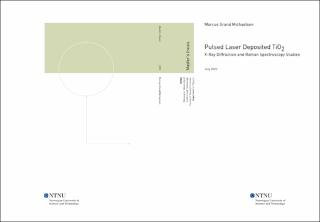| dc.description.abstract | Pulserende laserdeponerte TiO2-tynnfilmer har blitt undersøkt ved røntgen-diffraksjon (XRD) og ramanspektroskopi. Utvalget av TiO2-tynnfilmer bestod av både udopede og (Cr,N)-dopede filmer. Bakgrunnen for studien var å undersøke (Cr,N)-dopet TiO2 som en kandidat for å realisere mellombånd-solceller. Mellombånd-solceller er et konsept som tilhører tredje generasjons solceller, hvor målet er å øke energieffektiviteten utover dagens konvensjonelle solceller.
Serien med udopede TiO2-tynnfilmer var deponert gjennom konvensjonell pulserende laserdeponering (PLD). Serien bestoed av seks uniforme filmer, hver av dem deponert med forskjellige deponeringsparametre, som hadde blitt deponert på fire substrater samtidig: Si (100), LAO (001), STO (001) og safir (0001). I denne oppgaven ble filmene undersøkt gjennom konvensjonell Theta-2Theta XRD, Grazing-Incidence XRD (GIXRD), High Resolution XRD (HRXRD) og ramanspektroskopi. Det ble observert at mengden rutil til anatase, tekstur og strukturell kvalitet kunne påvirkes ved å variere oksygentrykket under deponering. Det ble også observert at mengden rutil til anatase var sterkt påvirket av valg av substrat. Noen av filmene på LAO (001) og STO (001) bestod av teksturert, (001)-orientert anatase, selv for deponeringsparametre som så ut til å favorisere polykrystallinsk rutilvekst. For disse filmene ble det også observert at uteksturert rutil framkom sammen med teksturert anatase. De forskjellige XRD-teknikkene ble evaluert, og det ble konkludert med at GIXRD-metoden ikke var tilstrekkelig for å beskrive flere av filmene.
Utvalget av (Cr,N)-dopede TiO2-filmer va deponert ved kombinatoriell PLD. Dette hadde resultert i filmer med en kontinuerlig gradient i dopingkonsentrasjoner gjennom prøven. For noen av filmene hadde deponeringsgassen blitt syklet mellom O2 og N2 for å hindre dannelsen av kromoksider, og derfor øke mengder nitrogen i filmene. Tegn til CrO2 eller Cr2O3 ble observert for alle de dopede prøvene. Det ble funnet at både (Cr,N)-doping samt N2-gass frambringte rutil (001) i filmene. For lave dopingkonsentrasjoner og deponering under ren O2 gass ble teksturert anatase (001) observert.
Den konvensjonelle Theta-2Theta XRD-metoden var en effektiv teknikk for å gjøre strukturell karakterisering av filmene. Konklusjonene som fremkom av XRD-dataene samstemte generelt godt med konklusjonene fra ramanspektroskopi, så vel som transmisjons elektronmikroskopidata til en lignende prøve for en av de dopede prøvene presentert her. | |
| dc.description.abstract | Pulsed laser deposited TiO2 thin films have been investigated using X-Ray diffraction and Raman spectroscopy. The studied TiO2 films were undoped and (Cr,N)-codoped. The background for this study was to investigate (Cr,N)-codoped TiO2 as a candidate for realizing intermediate band materials, for use in intermediate band solar cells---a proposed addition to the third generation of solar cells, aiming to surpass the maximum efficiency of conventional solar cells.
The series of undoped TiO2 films was deposited using conventional pulsed laser deposition (PLD). The series consisted of six uniform films, each with different deposition parameters, that had been simultaneously deposited on Si (100), LAO (001), STO (001) and sapphire (0001) substrates. In this thesis the films were studied using conventional Theta-2Theta X-Ray Diffraction (XRD), Grazing-Incidence X-Ray-Diffraction (GIXRD), High Resolution X-Ray Diffraction (HRXRD) and Raman spectroscopy. It was found that the amount of rutile or anatase, texture and structural quality could be tuned by varying the oxygen pressure during deposition. It was also observed that the amount of rutile or anatase in the film was largely influenced by the choice of substrate. Some films on LAO (001) and STO (001) were found to consist of textured, (001)-oriented anatase, even for deposition conditions which favored growth of polycrystalline rutile. However, for these samples the textured anatase seemed to coexist with un-textured, polycrystalline rutile. The different XRD techniques used were evaluated, and it was concluded that the GIXRD method proved insufficient in describing several of the thin films.
The (Cr,N)-codoped TiO2 films was a series of films deposited using combinatorial PLD. This had resulted in films with continuous gradients in doping concentrations across the samples. For some of the films, the gas flow during deposition had been cycled between O2 and N2 in order to hinder formation of chromium oxide, and thus increase the amount of nitrogen in the films. In this thesis it was found that (Cr,N)-codoping, as well as cycling between O2 and N2 gas, negatively affected the overall structural quality of the films. Furthermore, characteristics of CrO2 and Cr2O3 was found for all of the doped samples. However, both (Cr,N)-doping and cycling to N2 seemed to favor growth of rutile (001). For low doping concentrations and deposition under pure O2 gas, textured (001)-anatase was observed.
The conventional Theta-2Theta XRD method proved to be an efficient method of characterizing the structural composition of the films. The conclusions drawn from the XRD data generally agreed with the conclusions drawn from Raman spectroscopy, as well as Transmission Electron Microscopy data from the study of a sample that was similar to one of the doped samples presented here. | |
